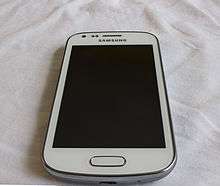Samsung Galaxy Ace 2
 | |
|
| |
| Manufacturer | Samsung Electronics |
|---|---|
| Series | Galaxy |
| Compatible networks |
GSM 850/900/1800/1900 MHz 3.5G 900/2100 MHz Canada: HSPA 850/1900 MHz |
| First released | UK May 22, 2012 |
| Predecessor |
Samsung Galaxy Ace Samsung Galaxy Ace Plus |
| Successor | Samsung Galaxy Ace 3 |
| Type | Smartphone |
| Form factor | Slate |
| Dimensions |
118.3 mm (4.66 in) H 62.3 mm (2.45 in) W 10.5 mm (0.41 in) D |
| Weight | 122 g (4.3 oz) |
| Operating system | Android 2.3.6 Gingerbread (upgradeable to 4.1.2 Jelly Bean)[1] and Android 5.1 Lollipop via Custom Roms |
| System on chip | ST-Ericsson NovaThor U8500 |
| CPU | Dual-core 800 MHz ARM Cortex-A9 |
| GPU | ARM Mali-400 MP |
| Memory | 768 MB RAM (accessible: 555-624 MB depending on kernel parameters) |
| Storage | 4 GB (1GB accessible) |
| Removable storage | microSD up to 32 GB |
| Battery | 1,500 mAh, 5.55 Wh, 3.7 V, internal rechargeable Li-ion, user replaceable |
| Data inputs |
Multi-touch, capacitive touchscreen Accelerometer A-GPS GLONASS Digital compass Proximity sensor Push buttons Capacitive touch-sensitive buttons |
| Display |
3.8 in (97 mm) TFT LCD diagonal. 480x800 px (244ppi) WVGA 16M colors |
| Rear camera | 5 Mpx 2560x1920 max, autofocus, LED flash, HD video recording 1280x720 px MPEG4 at 30 FPS |
| Front camera | VGA |
| Connectivity |
3.5 mm jack Bluetooth v3.0 with A2DP DLNA Stereo FM radio with RDS Micro-USB 2.0 Near field communication (NFC)* *GT-I8160P model only Wi-Fi 802.11 b/g/n |
| Other | Swype keyboard, Google Play, Polaris™ Office, ChatON, Social Hub, Readers Hub and Game Hub |
| SAR |
Head: 0.69 W/kg 1 g Body: 1.31 W/kg 1 g Hotspot: -[2] |
Samsung Galaxy Ace 2 (GT-I8160) is a smartphone manufactured by Samsung that runs the open source Android operating system. Announced and released by Samsung in February 2012, the Galaxy Ace 2 is the successor to the Galaxy Ace Plus.[3]
Galaxy Ace 2 is one of Samsung's cost effective, dual-core Android-based smartphones. Being an upper-mid-range smartphone, Galaxy Ace 2 contains hardware between that of the Galaxy Ace Plus and Galaxy S Advance; it features a dual-core 800 MHz processor on the NovaThor U8500 chipset with the Mali-400 GPU.
In May 2012, the device went on sale in the UK.[4]
Hardware
Galaxy Ace 2 is a 3.5G mobile device that offers quad-band GSM, and is announced with dual-band 900/2100 MHz HSDPA at 14.4 Mbit/s downlink and 5.76 Mbit/s uplink speeds. The display is a 3.8-inch capacitive PLS TFT LCD touchscreen with 16M colours in a WVGA (480x800) resolution. There is also a 5-megapixel camera with LED flash and auto-focus, capable of recording videos at QVGA (320x240), VGA (640x480) and HD (1280x720) resolutions. Galaxy Ace 2 also has a front-facing VGA camera. The device comes with a 1500 mAh Li-Ion battery.[5]
Software
Galaxy Ace 2 comes with Android 2.3.6 Gingerbread and Samsung's proprietary TouchWiz 4.0 user interface. In September 2012, Samsung announced that Galaxy Ace 2 would be updated to Android 4.1 Jelly Bean.[6] The phone can be upgraded to Android 4.1.2 Jelly Bean.[1]
Galaxy Ace 2 has social network integration abilities and multimedia features. It is also preloaded with basic Google Apps, such as Google+ and Google Talk. The phone is available in Onyx Black and in White colours.
The device also unofficially supports CyanogenMod versions up to 11.0 (Android 4.4.4)[7] as well as other AOSP-derived roms like AOKP.
Samsung Galaxy Ace II x / Trend

Galaxy Ace II x (GT-S7560M) and in some markets Galaxy Trend (GT-S7560) are at first glance variants of Galaxy Ace 2. In that both have a similar shell and specifications, such as the slightly larger 4" screen, and similar specs for RAM and storage space. However, the Snapdragon S1 MSM7227A SoC design is much closer to that of Samsung Galaxy Mini 2; these phones contain a single-core 1 GHz ARM Cortex-A5 ARMv7 CPU in conjunction with an enhanced Adreno 200 GPU—instead of the 800 MHz dual-core CPU of Samsung Galaxy Ace 2.
Galaxy Ace II x and Galaxy Trend have 645 MB of accessible RAM, and approximately 2 GB of user-accessible internal storage. The devices are powered by Android 4.0.4 Ice Cream Sandwich, running Samsung's proprietary TouchWiz Nature UX as the default user interface.[8]
Galaxy S Duos (GT-S7562) is available with very similar specifications; the major differentiating feature is its dual-SIM support.
The operating systems can be upgraded to somewhat newer official versions of Android 4.x than the factory install.
See also
References
- 1 2 "Samsung Galaxy Ace 2 Jelly Bean 4.1.2 update touches down". phonesreview.co.uk. 2013-04-02. Retrieved 2013-04-03.
- ↑ https://apps.fcc.gov/oetcf/eas/reports/ViewExhibitReport.cfm?mode=Exhibits&RequestTimeout=500&calledFromFrame=N&application_id=264550&fcc_id=%27A3LGTS5830%27, ID=1387665
- ↑ "Play and Share Faster and Smarter with the GALAXY Ace Plus". Samsung View. 2012-01-03. Retrieved 2012-01-03.
- ↑ "SAMSUNG GALAXY ACE 2". Samsung View. 2012-01-05. Retrieved 2012-01-05.
- ↑ "Samsung Galaxy Ace 2 S8160 - Full phone specifications". Gsmarena.com. Retrieved 2012-02-13.
- ↑ "Samsung details Jelly Bean upgrade roadmap (and it’s not all good)". slashgear.com. Retrieved 2012-09-24.
- ↑ "Unofficial Cyanogenmod for Ace 2". Retrieved 2014-06-17.
- ↑ "Samsung Galaxy Ace II X S7560M". Retrieved 11-04-2013. Check date values in:
|access-date=(help)
| ||||||||||||||||||||||||||||||||||||||||||||||||||||||||||||||||||||||||||||||||||||||||
| |||||||||||||
